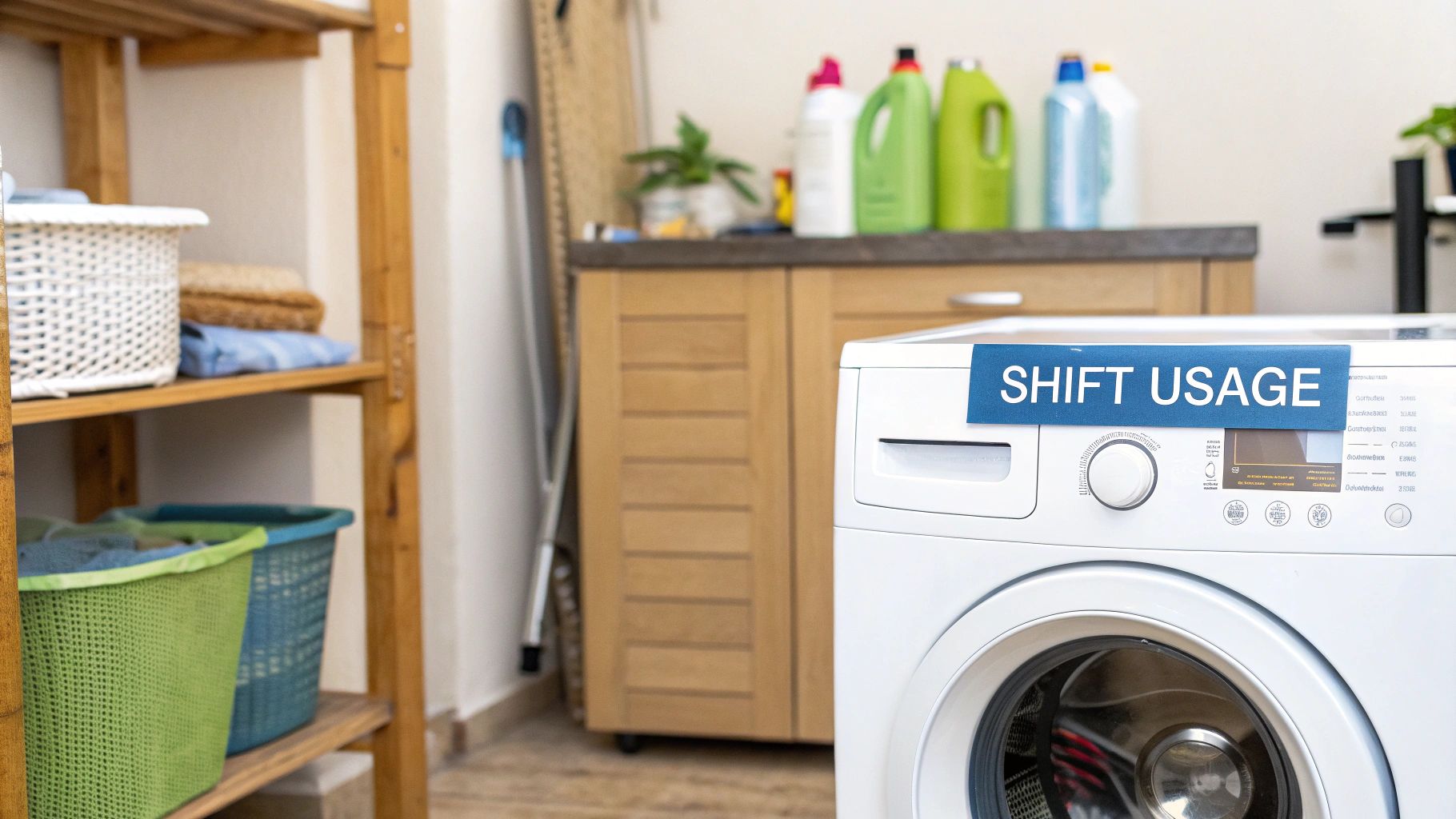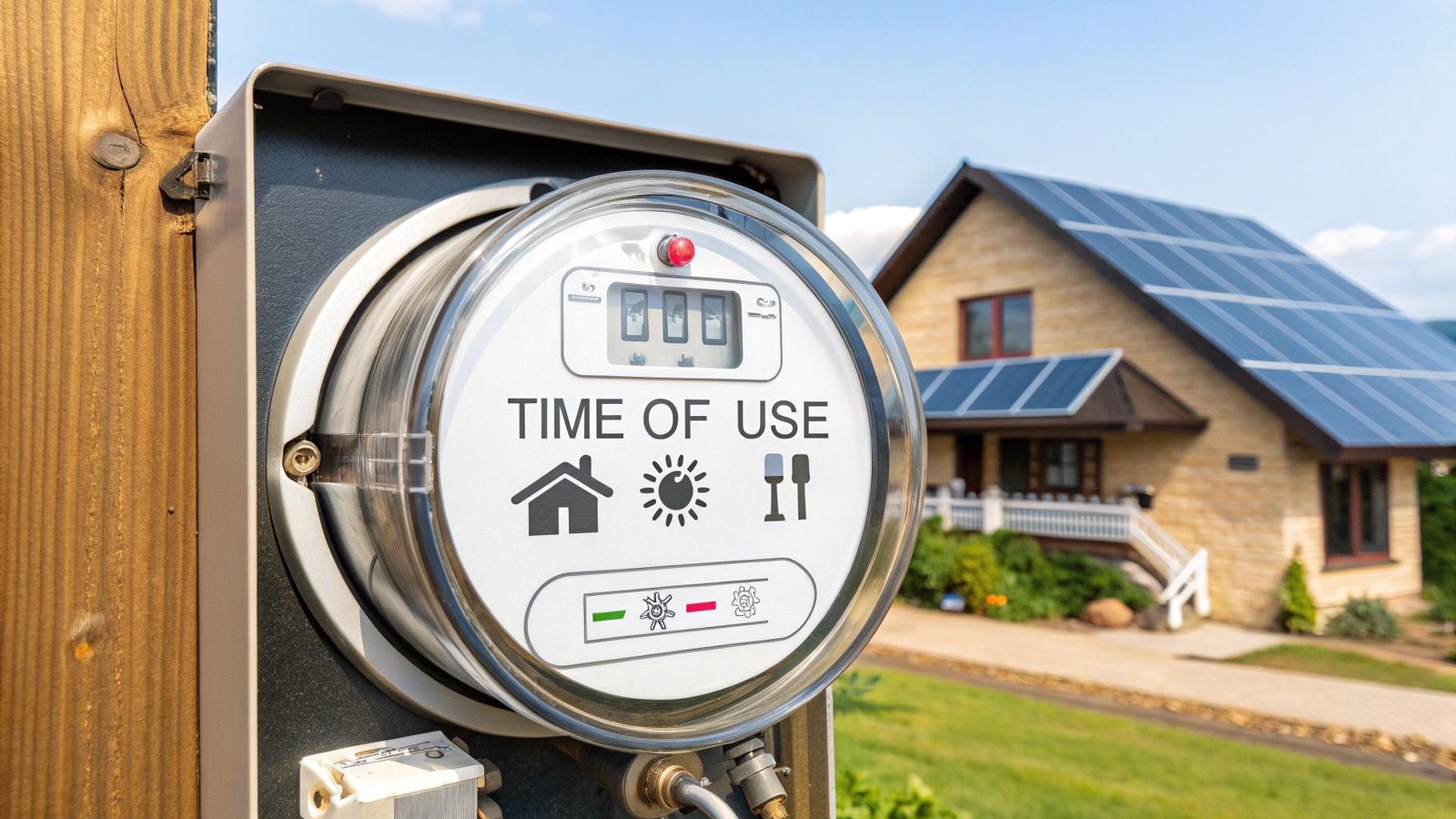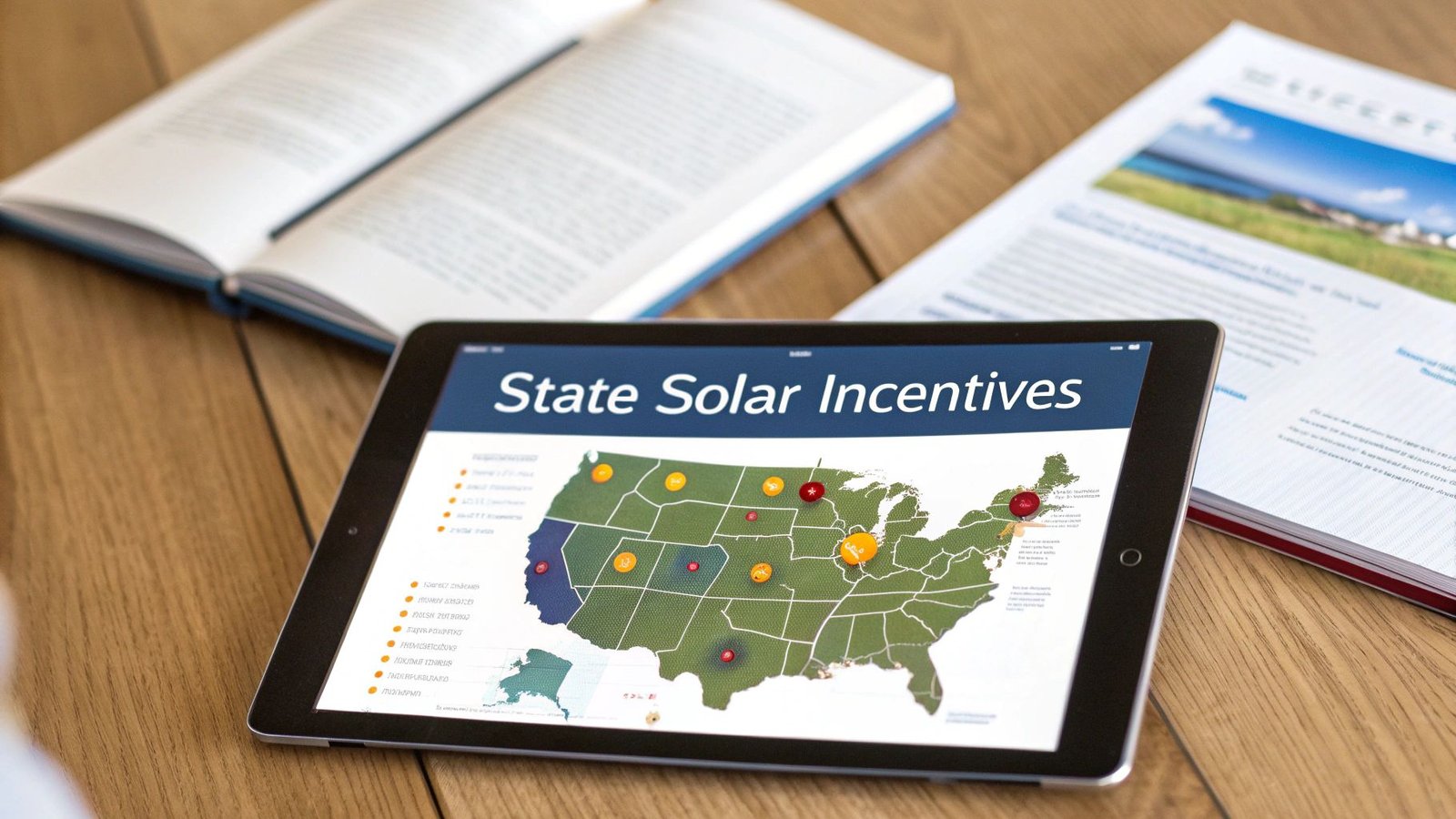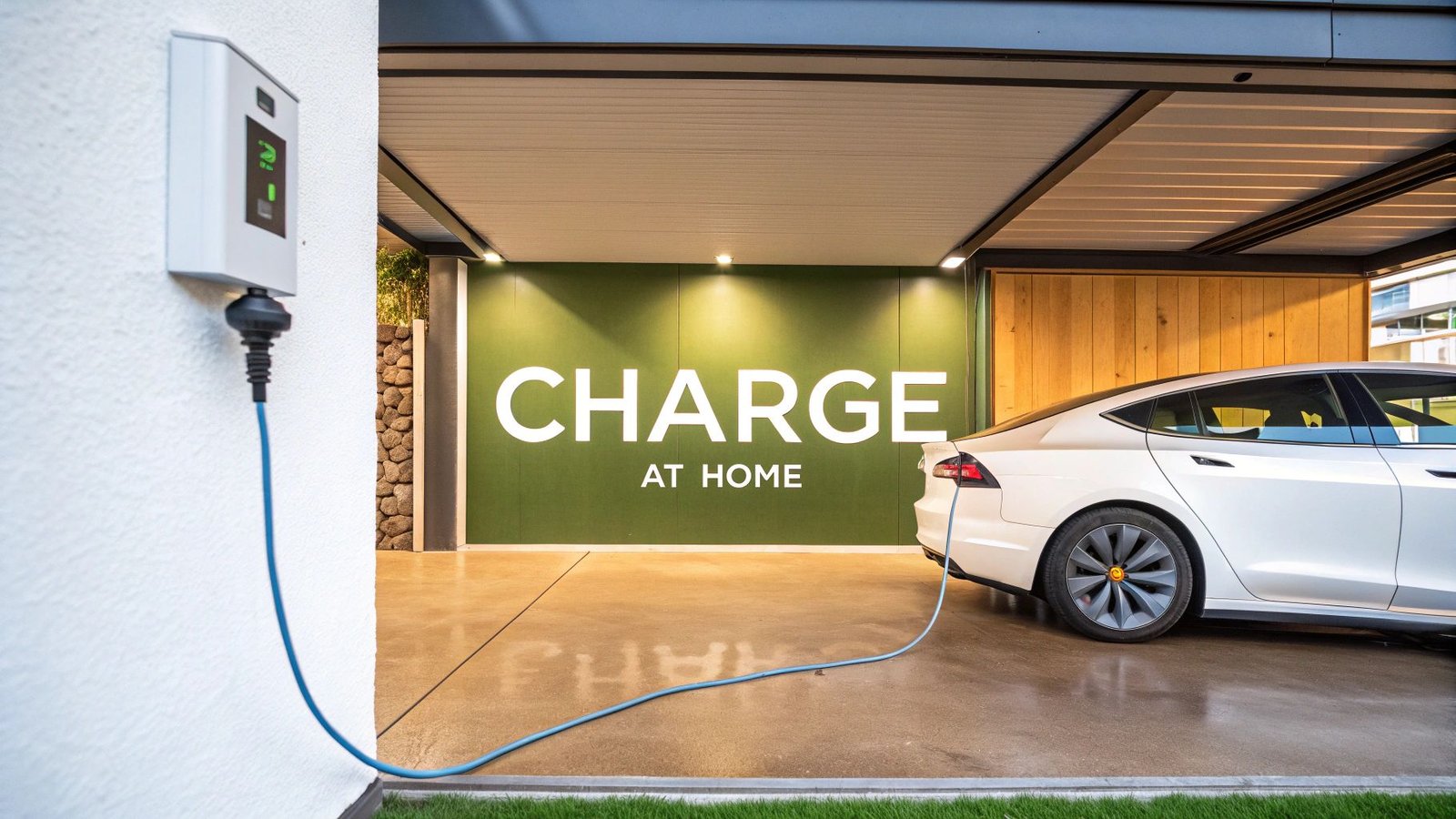Think of time-of-use electricity rates like surge pricing for your power bill. You know how an Uber ride costs more during rush hour? It’s the same basic idea. Electricity is more expensive during high-demand "peak" hours and cheaper when demand is low, during "off-peak" hours.
This strategy helps electricity companies manage the immense strain on the power grid.
What Are Time of Use Electricity Rates?
Picture the electrical grid as a massive highway system. During the morning and evening commute, the roads are jammed. To ease that congestion, cities might encourage public transit or carpooling. Time-of-use (TOU) rates do something similar for our electricity consumption. Instead of charging one flat rate all day, the price changes based on how much power everyone is using.
This pricing structure nudges us to shift our big energy tasks—like running the dryer or charging an electric car—to times when the grid isn't under so much pressure. If you can make a few small adjustments, you can see a real drop in your monthly bill. At the same time, you’re helping the utility keep the lights on for everyone without having to build new power plants.
The core concept is simple: use less electricity when it costs more.
The Different Pricing Tiers Explained
Most TOU plans break the day down into a few key time blocks, each with a different price per kilowatt-hour (kWh). The exact hours can change depending on your utility provider and even the season, but they generally follow this pattern:
- On-Peak: This is prime time for electricity use, making it the most expensive period. It's usually in the late afternoon and early evening (think 4 PM to 9 PM) when people are getting home, making dinner, and turning on their TVs.
- Off-Peak: This is the cheapest time to use power. It typically covers the overnight hours and most of the weekend when overall electricity demand hits a low point.
- Mid-Peak (or Shoulder): Some plans have this in-between tier. The price is higher than off-peak but lower than on-peak, covering the periods just before and after the big rush.
Here is a visual breakdown of how these tiers often look on a typical weekday:
gantt
title Typical Weekday TOU Pricing Tiers
dateFormat HH
axisFormat %H:00
section Rate Periods
Off-Peak :00, 10
Mid-Peak (Shoulder) :10, 6
On-Peak (Highest Cost) :16, 5
Off-Peak :21, 3
The whole point of this structure is to financially reward households that can shift their routines. For example, charging your EV overnight during off-peak hours could cost you a fraction of what it would during the evening peak.
Why Utilities Are Adopting This Model
The move to time-of-use pricing isn’t just a new fad. Utilities have been using this model for decades to manage the grid more efficiently. As our lives have become more electrified, this strategy is more critical than ever to prevent grid overloads on hot summer afternoons.
This pricing model also works hand-in-hand with the growth of renewable energy. When you understand how home solar works, you know that panels produce the most electricity in the middle of the day—often before the evening peak demand really kicks in. TOU rates encourage us to use power when it’s abundant and cheap, helping create a more balanced and sustainable energy system for everyone.
How Utilities Structure TOU Rate Plans
Utility companies don't just pull peak and off-peak hours out of a hat. Their time of use electricity rates are designed around the predictable rhythm of our daily lives—the collective hum of a community powering up and down. Think of it like managing traffic on the power grid. When everyone hits the road at once, congestion is high, and so are the prices. When the roads are clear, the toll is lower.
This whole system is built to mirror real-world energy demand. On a typical weekday, you see a massive surge in electricity use as people head home from work and school. Lights flick on, ovens start preheating for dinner, and air conditioners kick into high gear. This predictable spike puts the most strain on the grid, creating what's known as the on-peak window.
On the flip side, what happens late at night or over the weekend? Demand plummets. Most of us are asleep, and businesses have closed for the day. This lull creates the perfect opportunity for cheaper off-peak rates. By setting different prices, utilities are encouraging us to spread out our energy use and ease the burden on the grid.
Defining Peak, Off-Peak, and Mid-Peak Windows
The heart of any TOU plan is its schedule, usually broken down into two or three distinct periods. The exact times can vary depending on where you live and who your provider is, but they all follow a similar pattern. Getting a handle on this is the key to saving money.
- On-Peak Hours: This is prime time for electricity, and you pay a premium for it. It almost always falls on weekdays, typically between 4 PM and 9 PM. Using power during these hours costs you the most per kilowatt-hour (kWh).
- Off-Peak Hours: This is your green light for big savings. Off-peak periods are when rates are lowest, usually covering late-night hours (say, after 10 PM), early mornings, and the entire weekend, plus major holidays.
- Mid-Peak (or Shoulder) Hours: Some utilities use this middle tier. These are the times when demand is just… moderate. It’s not the evening rush, but it’s not the middle of the night either. The price is set somewhere between the on-peak and off-peak rates.
This infographic gives you a great visual of how modern smart home technology can help track your energy use across these different periods.

The smart meter shown in the image is what makes TOU billing possible. It records when your home uses electricity, not just how much, which is what allows your utility to charge you accurately based on the time of day.
To make this even clearer, let's break down what a typical day might look like under a TOU plan.
Typical Time of Use Rate Periods and Pricing
| Rate Period | Typical Time Window (Weekdays) | Relative Cost | Common Household Activities |
|---|---|---|---|
| On-Peak | 4 PM – 9 PM | Highest | Cooking dinner, running the dishwasher, watching TV, running A/C after work. |
| Mid-Peak | 10 AM – 4 PM | Moderate | Working from home, running small appliances, doing laundry (if not waiting). |
| Off-Peak | 10 PM – 7 AM & All Weekend | Lowest | Charging EVs, running laundry or dishwasher on delay, pre-cooling/heating the house. |
Seasonal Changes and Your Smart Meter
Don't get too comfortable with one schedule, though. TOU plans often change with the seasons. Summer brings scorching heat and a heavy reliance on air conditioning, pushing peak demand into the late afternoon and early evening. In winter, the grid sees demand spike in the morning as everyone cranks up their heat to start the day.
The secret weapon that makes all of this work is the smart meter. Old-school analog meters just gave a single reading for the whole month. A smart meter, on the other hand, is constantly at work, recording your electricity consumption in near real-time—often in 15-minute chunks.
This little device is what reports your usage back to the utility, giving them the granular data they need to bill you correctly on a time of use plan. Without a smart meter, this kind of dynamic pricing would be impossible. It’s the critical link between your daily habits and your monthly bill, putting the power to control your energy costs right back in your hands.
Why Time-of-Use Rates Are Popping Up Everywhere
The move to time-of-use electricity rates isn't just some local utility experiment; it’s a worldwide reaction to a power grid that's being stretched to its limits. Our collective hunger for electricity is growing fast, and it's not just because there are more of us. It's about a fundamental shift in how we power our lives.
Think about it. We're plugging in more electric vehicles, switching from gas furnaces to electric heat pumps, and powering countless new devices. All of this adds a massive new load to a grid that, in many places, was designed for a much simpler time. Trying to manage today's demand on yesterday's infrastructure is like squeezing a ten-lane highway's worth of traffic onto a two-lane road. Something has to give.
That's where time-of-use (TOU) rates come into play. They’re a clever tool for grid operators to steer consumption, prevent overloads, and keep the lights on for everyone. By making electricity cheaper when demand is low, TOU plans nudge us to shift our usage away from those chaotic "rush hour" peaks.
The Squeeze on Our Power Grids
The problem is that our electricity usage isn't a flat line anymore. For over 50 years, total global energy consumption has climbed nearly every single year, growing at a steady clip of around 1-2% annually. You can dig into the numbers and see how consumption patterns have evolved over time to get the full picture.
This constant upward trend isn't just an abstract statistic—it has very real consequences. Picture a scorching summer afternoon. Millions of air conditioners kick on at the same time, creating a colossal spike in demand that can push transformers and power lines to the breaking point. To handle that peak, utilities have to keep extra power plants on standby, ready to fire up for just a few hours a day. It’s an incredibly expensive and inefficient way to operate.
xychart-beta
title "Typical Daily Electricity Demand"
x-axis [0, 2, 4, 6, 8, 10, 12, 14, 16, 18, 20, 22, 24]
y-axis "Grid Demand" 0 --> 100
line [0, 40, 42, 45, 60, 75, 80, 78, 70, 95, 85, 60, 45, 40]
bar [0, 40, 42, 45, 60, 75, 80, 78, 70, 95, 85, 60, 45, 40]
By introducing TOU rates, utilities are essentially asking for our help. They’re giving us a financial reason to spread out our energy use, which in turn reduces the need to build pricey new power plants that would sit idle most of the time.
This simple change turns us from passive consumers into active partners in keeping the grid stable.
Matching Our Habits with Green Energy
There's another huge reason TOU rates are going global: the massive shift to renewable energy. Solar and wind power are the future, but they introduce a new wrinkle—their output isn't constant.
Solar panels, naturally, generate the most power in the middle of the day. Wind turbines spin whenever the wind is blowing. This doesn't always line up with our peak demand, which typically happens in the evening as people get home from work, cook dinner, and turn on their TVs. This mismatch creates what energy experts call the "duck curve"—a dip in demand from the grid midday (when solar is cranking) followed by a super steep ramp-up as the sun sets.
TOU rates are a brilliant way to smooth out that curve. They encourage us to sync our daily routines with the rhythm of renewable energy generation.
- Use more power when it's sunny: With cheap midday electricity, it just makes sense to run the dishwasher, do laundry, or charge your EV when solar energy is abundant.
- Ease up in the evening: As the sun goes down and demand spikes, higher prices give you a reason to hold off on running energy-hungry appliances.
This beautiful synergy helps build a more efficient and resilient grid. By making small adjustments to when we use electricity, we don't just lower our own bills—we help pave the way for a cleaner, more sustainable energy system for everyone.
Practical Strategies to Lower Your TOU Electricity Bill
Knowing how time of use electricity rates work is the first step, but the real power comes from using that knowledge to actually shrink your bill. The good news is that you don't need to completely upend your life to succeed on a TOU plan. It's more about making small, smart adjustments and letting technology do some of the heavy lifting.
The objective is pretty straightforward: shift as much of your power usage as you can away from the expensive "on-peak" hours and into the cheaper "off-peak" windows. You'd be surprised how much of a difference a few small tweaks to your daily routine can make over the course of a year. Here's a playbook you can start using right away.

Quick Wins Through Simple Habit Changes
The easiest place to start is by reconsidering the timing of your biggest energy-hogging chores. Most of them don't actually need to run during that pricey 4 PM to 9 PM window.
Here are a few simple changes that have an immediate impact:
- Laundry After Dark: Try to get into the habit of running your washing machine and dryer late at night or on weekends. A lot of modern appliances have a "delay start" feature that makes this incredibly simple to set and forget.
- Dishwasher Duty Overnight: It’s a classic for a reason. Go ahead and load the dishwasher after dinner, but just wait to press "start" until you're heading to bed. It'll run during the cheapest hours and be ready for you to unload in the morning.
- Pre-Cool Your Home: On a scorching day, run the A/C to cool your house down during the less expensive mid-peak afternoon. Once the peak rates kick in, you can nudge the thermostat up a few degrees and coast through the expensive period without being uncomfortable.
Leveraging Smart Home Technology
This is where you can really make your life easier. Smart home devices are your best friend when it comes to optimizing energy use, as they can automate the whole process so you barely have to think about it.
By automating your energy schedule, you move from actively managing your usage to a "set it and forget it" approach. This ensures consistent savings without requiring constant attention or effort.
Look into getting some of these tools on your side:
- Smart Thermostats: Gadgets from Nest or Ecobee are brilliant at this. They learn your family’s patterns and can be programmed to automatically dial back the heating or cooling during peak hours, saving you money without you even noticing.
- Appliance Timers and Smart Plugs: Got an older appliance without a built-in timer? No problem. A simple outlet timer or a smart plug can work wonders for things like pool pumps or electric water heaters, scheduling them to run only when power is cheap.
- EV Charging Schedulers: If you have an electric vehicle, this is a big one. Never charge it during peak hours. Use the scheduler in your car or charger to make sure it only starts sipping power late at night during the super off-peak window.
Advanced Optimization for Maximum Savings
Once you've got the basics down, you can dig a little deeper to find even more savings. This involves getting a clearer picture of your home's specific energy habits.
Monitoring your usage shows you exactly when your home is pulling the most electricity, pinpointing your biggest opportunities to save. A good solar monitoring system is perfect for this, as it gives you a detailed breakdown of when you're using grid power versus your own free solar energy. This kind of data is gold for fine-tuning your habits.
Putting these steps into practice will dramatically cut down your energy use during those costly peak hours. For even more ideas, check out these smart tips for saving electricity at home. By combining small behavioral shifts with the right technology and a little data, you can take full control of your electricity bill and turn your utility's TOU plan into a huge advantage.
Using Solar and Battery Storage to Maximize Savings

What if you could almost completely sidestep the highest time of use electricity rates? That’s not just wishful thinking—it's what happens when you combine solar panels with a home battery. This strategic duo gives you the power to generate your own clean energy and decide exactly when to use it.
Solar panels are brilliant, but on their own, they have one little hiccup when it comes to TOU schedules. They churn out the most power around midday, but the most expensive "on-peak" electricity rates typically kick in between 4 PM and 9 PM.
This timing mismatch is a classic problem. Your system might be forced to sell its valuable excess solar energy to the grid for pennies, only for you to buy expensive electricity back from the utility just a few hours later.
Bridging the Gap with a Home Battery
A home battery solves this problem elegantly. Think of it as your personal energy bank. Instead of exporting all that extra solar power during the day, your battery quietly stores it away for later.
Then, when the sun sets and those costly on-peak rates start, your home can automatically switch over to run on the free, clean energy saved in your battery. This simple act of shifting your own power lets you bypass the grid during the most expensive hours, which can make a huge difference in your monthly bill.
This strategy is often called energy arbitrage. You're essentially "buying" (or generating) energy when it’s free from the sun and "selling" it to yourself when grid power is most expensive. The savings come directly from the price difference.
By capturing your own solar power, you create a buffer against the utility's priciest rates. You’re no longer just a consumer at the mercy of the grid; you become the manager of your own energy supply.
How Energy Arbitrage Works Step-by-Step
The daily cycle of a solar-plus-storage system on a TOU plan is beautifully efficient and almost entirely automated. It creates a rhythm that maximizes your savings with zero effort.
Here’s a look at how a typical day unfolds:
- Morning to Midday (Off-Peak/Mid-Peak): Your solar panels are busy powering your home. Any extra energy they generate is used to charge your battery.
- Late Afternoon to Evening (On-Peak): Just as peak rates begin, your smart system stops pulling power from the grid. Instead, your home starts drawing from the fully charged battery, coasting through the evening on stored sunshine.
- Late Night (Off-Peak): Once your battery has been used and peak hours are over, your home switches back to the grid for any overnight power needs, now at the cheapest off-peak prices. The whole cycle repeats the next morning.
More Than Just Savings
This powerful combination does a lot more than just cut your utility bill. It drastically increases your energy independence. With a charged battery, you have a reliable backup power source during grid outages, keeping your lights on and essentials running when the neighborhood goes dark.
Plus, by using less grid power during peak demand, you're helping to stabilize the entire energy system. When enough homes do this, it reduces the strain on utilities, helping prevent blackouts and lessening the need to fire up expensive, polluting "peaker" plants. Understanding how to store solar energy is the key to unlocking these benefits for both your wallet and the wider community.
Seeing the Real World Impact on Your Wallet
It’s one thing to talk about time-of-use electricity rates in theory, but what does it actually mean for your bank account? Let's look at the real-world dollar impact.
To really see what’s at stake, we can compare two neighboring households. They’re on the exact same TOU plan, but one family ignores the schedule completely while the other actively shifts when they use power. The difference in their monthly bills can be staggering.
The family that makes a conscious effort to run their big appliances during off-peak hours consistently pays less. This isn't about making huge sacrifices; it's just about smart timing. A few simple habit changes can turn into real financial gains.
A Tale of Two Households
Imagine both families have the same major appliances and similar daily routines. Household A pretty much runs on autopilot. They’ll run the dishwasher right after dinner and throw in a load of laundry on a weekday afternoon—smack in the middle of peak hours.
Household B, on the other hand, is strategic. They schedule those same tasks to run overnight or on the weekend, making sure to cash in on that cheaper, off-peak electricity.
The daily cost difference might seem small at first, maybe just a dollar or two. But it adds up fast. Those small daily savings compound into a significant amount by the end of the year.
Here’s a simple look at what their daily electricity costs for the same jobs might be:
| Appliance Usage | Household A (Ignores TOU) | Household B (Optimizes TOU) |
|---|---|---|
| Dishwasher (1.5 kWh) | Runs at 7 PM (Peak Rate: $0.35/kWh) = $0.53 | Runs at 11 PM (Off-Peak: $0.15/kWh) = $0.23 |
| Laundry (3 kWh) | Runs at 5 PM (Peak Rate: $0.35/kWh) = $1.05 | Runs on Saturday (Off-Peak: $0.15/kWh) = $0.45 |
| Total Daily Cost | $1.58 | $0.68 |
| Projected Monthly Savings | ~$27.00 | |
| Projected Annual Savings | ~$324.00 |
pie title="Annual Savings from TOU Optimization: $324"
"Saved by Shifting Usage" : 324
Why Your Location Matters
These savings can become even more dramatic depending on where you live. In the United States, average electricity prices are all over the map, ranging from about 11.7¢/kWh in some states to a whopping 42.5¢/kWh in others.
Utilities in many major cities push average costs over 31¢/kWh, which makes shifting your energy use a powerful tool for managing your bill. You can get a sense of how global electricity prices vary to see the bigger picture.
For solar homeowners, tracking these savings is absolutely essential. A big part of that is understanding the solar true-up meaning on your utility bill. This annual statement squares up your solar production against your grid consumption, and your TOU strategy has a direct impact on whether you owe money or get a credit.
Answering Your Top Questions About TOU Rates
Diving into time of use electricity rates can feel a little confusing at first. Let's clear up some of the most common questions people have so you can feel confident about your energy choices.
Am I Being Forced Onto a TOU Plan?
This is probably the number one question we hear, and the answer is… it depends. It really comes down to where you live and who your utility provider is.
For most people, TOU plans are simply an option—something you can choose to join if it fits your lifestyle. However, some utilities, especially in places like California, are making TOU the default or even mandatory plan for certain customers, particularly those installing new solar panels.
The best advice? Check directly with your utility. Their website is usually the quickest way to see what's required and what's optional for you.
What If My Schedule Is Too Hectic to Avoid Peak Hours?
Life happens. Maybe you work from home during the day, or maybe the kids' after-school routine means the dishwasher and laundry are running right in the middle of that expensive 4 PM to 9 PM window. If you genuinely can't shift your big energy draws, a TOU plan could end up costing you more. It's a valid concern.
Luckily, you're not stuck. Most utilities still offer old-school flat-rate plans.
A flat-rate plan is exactly what it sounds like: you pay the same price for electricity no matter what time of day it is. You won't get the deep discounts of off-peak hours, but you also won't get stung by peak-hour price spikes. It offers predictability, which is perfect for households with rigid schedules.
How Do TOU Rates Work if I Own an Electric Vehicle?
If you have an EV, a TOU plan isn't just a good idea—it's practically a superpower for saving money. Think about it: when do most people charge their car? Overnight, while they're sleeping.
This lines up perfectly with the super off-peak window when electricity is cheapest. Just plug in your car when you get home and use the vehicle’s scheduling feature to start charging after 9 PM or midnight. It’s a simple habit that turns your "fuel" costs into a tiny fraction of what you'd pay at the pump or if you charged during peak hours.
Can I Get Off a Time of Use Plan if I Don't Like It?
Yes, you can almost always opt-out. If you've given the TOU plan a try and it's just not saving you money or is too much of a hassle, you're not locked in forever.
Most utilities will let you switch back to a standard plan, though they might limit you to one change per year. It's always a good idea to check your provider's specific policy so you know what the process involves.
Ready to take control of your energy costs and explore a sustainable future? Radiant Energy provides high-quality solar energy solutions, including solar panel installation, energy storage, and EV charging, to help you achieve energy independence. Learn how we can design the perfect system for your home by visiting us at https://radiantenergysolar.com.




